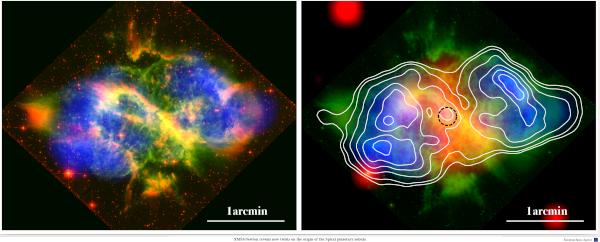XMM-Newton reveals new twists on the origin of the Spiral planetary nebula

Minimum credit line: Image courtesy of J.A. Toalá, R. Montez Jr and M. Karovska and ESA. (for details, see Conditions of Use).
The image above can be displayed at full size and may be downloaded by clicking the image above.
| About this Image |
|---|
NGC 5189, also called the Spiral Planetary Nebula, is at such an advanced phase in its evolution that X-rays from its internal hot bubble should have faded. However, XMM-Newton has revealed the presence of a large carbon-rich hot bubble embedded within the spiraling nebulosity. This is the largest hot bubble detected to date from the planetary nebula phase of sun-like stars and indicates the potential resurgence of the progenitor star of NGC 5189. The images feature a combination of space-based observations from the Hubble Space Telescope (HST), Wide-field Infrared Survey Explorer (WISE), and the XMM-Newton. The left panel shows a combination of ionized hydrogen (red) and oxygen (green) from HST and X-ray emission (blue) from XMM. The right panel shows the infrared emission from WISE (red), ionized oxygen from HST (green), and X-ray emission from XMM (blue), with contours further detailing the location of the X-ray emission and the dashed-line circle indicating the position of the progenitor star.
Investigator(s): J.A. Toalá, R. Montez Jr and M. Karovska
| For More Information |
|---|
- Detailed description of this image
- Query XSA archive for XMM-Newton data in the field of NGC 5189
- Astronomical database entries for NGC 5189;
- Query SIMBAD for more NGC 5189 data
- For unfamiliar terms, visit the XMM-Newton Astronomical Glossary
| Instrument | EPIC | ||
| Observing Mode | Full Frame | ||
| Filter | Thin | ||
| Date of Observation | 2018-02-05 | ||
| Image size | 0.00 x 0.00 arcsec | ||
| Detailed Caption | Planetary nebulae (PNe) represent a fleeting phase of stellar material lost by solar-like stars. Within the short-lived planetary nebula phase a hot bubble forms early when the star drives a strong stellar wind but fades within a few thousand years. In particular, the Chandra Planetary Nebula Survey (CHANPLANS) only detected X-ray emitting hot bubbles from young (<5,000 year) and compact (< 0.2 pc) nebulae and predominantly from those that harbor hydrogen-deficient progenitor stars. New observations by XMM-Newton have revealed a carbon-rich hot bubble inside NGC 5189 with a temperature of 1.6 million degrees. The hot bubble fills the cavities seen in the Hubble Space Telescope [O III] image. NGC 5189 is intriguing in that its inner cavities are much larger (~0.7 pc) than any previously-detected hot bubble. Additionally, its central star exhibits high luminosity and temperature and Wolf-Rayet-like features. Together these characteristics suggest that the nebula is old but the star seems to have been recently rejuvenated. A similar situation has been reported in so-called "born-again" PNe A30 and A78. Born-again PNe represent a very specific evolutionary path of solar-like stars in which a very late thermal pulse ejects carbon-enriched material inside an evolved, hydrogen-rich PNe. After the born-again event a new fast wind is developed, powering a carbon-rich hot bubble. In the figure we show a comparison between the soft X-ray emission (0.3 - 0.7 keV) detected with the European Photon Imaging Camera (EPIC) on board XMM-Newton with that of the Hα and [O III] obtained with Hubble Space Telescope (HST) and the WISE 12 micron band. | ||
| Alternate Resolutions | (Help) |
|---|
This image is available in the following downloadable versions: Higher resolution versions of this image may be available, please contact the XMM-Newton HelpDesk.
Search the Image Gallery
To search the Image Gallery for a particular object, fill in the object name in the box below and click the Submit button.To search the Image Gallery for other images, fill in any of the fields below and click the Submit button.
For more search options, please use our Advanced Search form.